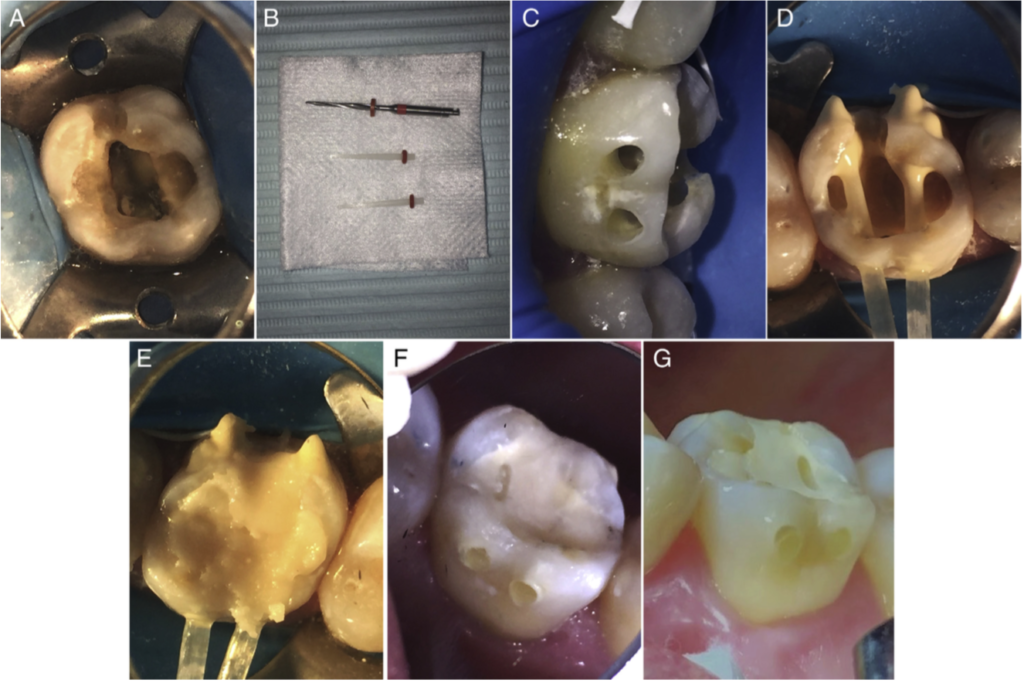As endodontic systems and methods of disinfection advance, most endodontic failures are due to root or crown fractures, instead of re-infections. As clinicians we tend to make a significant compromise when doing root canal treatments. To gain straight-line (less than conservative) access in order to achieve close to complete disinfection, we compromise the rigidity of the tooth itself. Performing full crown coverage of the same tooth significantly protects against the possibility of fractures, but a large portion of the patient population cannot financially accept this treatment.
Several recent studies have outlined how horizontally placed posts, embedded in resin running in the bucco-lingual direction increases fracture resistance in endodontically treated teeth.
Case Report – Presented by Kim et al.
A 40-year-old man presented to the dental clinic we a sharp spontaneous pain on the upper right side, present for 4 day. The pain is worse during the night and prevents the patient from sleeping.
- The patient reports no thermal sensitivity.
- General extra-oral and intra-oral exam were within normal limits.
- The upper right first molar showed sensitivity to palpation and percussion.
- Probing depths of the upper right first molar were within normal limits.
- A periapical radiograph showed a periapical radiolucency on the distobuccal root of the upper right first molar. All other teeth in the quadrant where within normal limits.
- The diagnosis: Pulp necrosis with symptomatic apical periodontitis.
Following endodontic treatment of the teeth, post/core/ and crown coverage were suggested to the patient, however due to financial constraints, the patient could not initiate treatment. Therefore, 2 horizontally placed posts were planned in order increase fracture resistance.
- 2 transverse holes were prepared through the buccal and lingual walls of the tooth, using a #1 (0.9mm) double-tapered post drill.
- The radiopaque translucent fiber post system (Bisco Inc) was used, and two fiberglass posts were fitted.
- The cavity was acid etched and prime/bond was applied to the chamber. Flowable composite (Henry Schein) was placed over the pulpal floor.
- Flowable composite was also used to cement the fiberglass posts.
- Compactible composite (Natural Elegance, Henry Schein) was used to restore the remaining cavity, encompassing the 2 horizontal posts.
- The portion of the posts protruding from the buccal and lingual walls were cut and polished.

Placing horizontal posts is a relatively simple yet effective way of increasing fracture resistance, while waiting for full crown coverage restoration. Karzoun et al. has shown that placing a single horizontal fiberglass post running buccolingually doubled the fracture resistance of a molar over a tooth with composite alone. Bromberg et al. showed increase in fracture resistance by 60% when placing 2 horizontal fiberglass posts. Furthermore, even when fractures do happen, research shows that teeth with horizontal posts are repairable 80% of the time, while teeth with conventional resins without horizontal posts are repairable only 30% of the time.
Placing horizontal posts can prevent many of the dangers of vertical posts, such as dentin stripping, leading to inherent craze lines, ultimately resulting root fractures. Moreover, if a vertical post is still needed, it can be placed easily as the horizontally placed posts do not block the access.


